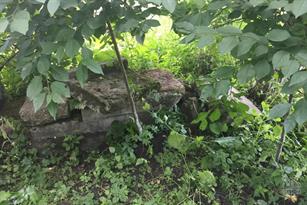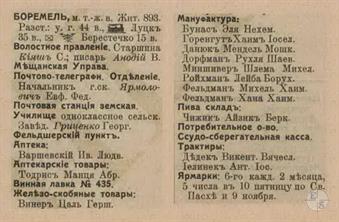Boremel
Dubno district, Rivne region
Sources:
- Jewish encyclopedia of Brockhaus & Efron
- Russian Jewish encyclopedia. Translated from Russian by Eugene Snaider
- Yad Vashem. Boremel
- The All South-Western Territory: reference and address book of the Kyiv, Podolsk and Volyn provinces. Printing house L.M. Fish and P.E. Wolfson, 1913
Photo:
- European Jewish Cemeteries Initiative. Boremel Jewish Cemetery
- Wikipedia. Boremel
- Jewish encyclopedia of Brockhaus & Efron
- Russian Jewish encyclopedia. Translated from Russian by Eugene Snaider
- Yad Vashem. Boremel
- The All South-Western Territory: reference and address book of the Kyiv, Podolsk and Volyn provinces. Printing house L.M. Fish and P.E. Wolfson, 1913
Photo:
- European Jewish Cemeteries Initiative. Boremel Jewish Cemetery
- Wikipedia. Boremel
Known since 1366. Since 1795 - as part of the Russian Empire. In the 19th - beginning of the 20th century - the township of Boreml (another name of Mikhailovka) of the Dubno district of the Volyn province. In 1919–39 - in the Volyn Voivodeship as part of Poland, in 1939–91 - as part of the Ukrainian SSR.
In 1784, 25 Jews lived in Boremel,
in 1847 - 411,
in 1897 - 1047 (87.4%),
in 1911 - 893,
in 1921 - 857 (96%),
in 1931 - 934,
in 1941 - 1018 Jews.
First Jews settled in Boremel before 1782. The Jews of Boremel were engaged in gardening, trade (including forest), crafts.
In the 19th century there were 3 synagogues.
Since 1885, the rabbi was Hilel Shek. The Jews of Boremel were mainly Olyka's and Triysk's Hasids.
In 1784, 25 Jews lived in Boremel,
in 1847 - 411,
in 1897 - 1047 (87.4%),
in 1911 - 893,
in 1921 - 857 (96%),
in 1931 - 934,
in 1941 - 1018 Jews.
First Jews settled in Boremel before 1782. The Jews of Boremel were engaged in gardening, trade (including forest), crafts.
In the 19th century there were 3 synagogues.
Since 1885, the rabbi was Hilel Shek. The Jews of Boremel were mainly Olyka's and Triysk's Hasids.
From the beginning of the 20th century, “Agudas Dobrey Sfas Ever” (“Union of speakers in Hebrew”) acted in the town.
In 1902, a library was organized.
In 1913, Jews owned only pharmacy warehous, only beer warehous (Aizik Chixhyk), and all 9 shops in township.
During the 1st World War, Boremel was badly affected.
In 1919–22, the school of Tarbut network was working, closed by the Polish authorities.
The center of the public life of the town in the 1920-30s there was a library, in which the dramatic circle acted.
The departments of ha-Shomer ha-Tsair, he-Khaluts ha-Tsair, Beitar, Gordonia worked.
After September 17, 1939, in the aftermath of the Ribbentrop-Molotov Pact, the Red Army entered Boremel, and the town became part of Soviet Ukraine.
In 1902, a library was organized.
In 1913, Jews owned only pharmacy warehous, only beer warehous (Aizik Chixhyk), and all 9 shops in township.
During the 1st World War, Boremel was badly affected.
In 1919–22, the school of Tarbut network was working, closed by the Polish authorities.
The center of the public life of the town in the 1920-30s there was a library, in which the dramatic circle acted.
The departments of ha-Shomer ha-Tsair, he-Khaluts ha-Tsair, Beitar, Gordonia worked.
After September 17, 1939, in the aftermath of the Ribbentrop-Molotov Pact, the Red Army entered Boremel, and the town became part of Soviet Ukraine.
 |
 |
 |
| Palace in Boremrl. Drawing by Napoleon Orda, 18 century | The watermill of Marmudsky, 1935 | The fair in Boremel, 1939 |
The Germans occupied Boremel on June 25, 1941. At the time of the German invasion, local Ukrainians took the opportunity to rob the Jews, and a few of the latter were killed. The Germans ordered systematic requisitions of Jewish property and valuables.
The German authorities established a Jewish council (a "Judenrat"), consisting of seven men, and a Jewish police force. The Jews had to wear yellow patches and perform forced labor, with almost all the young Jewish men being taken to Dubno and Rуwne for work. Most never returned; in all likelihood, they were killed in those places, along with the local Jews.
Of those Jews who remained in Boremel, many were taken to work on farms in the surrounding villages. Apart from these work assignments, Jews were not permitted to leave the village.
In June 1942, the Germans established a ghetto at the edge of the town. Some Jews were killed for leaving the ghetto in an attempt to obtain some food. Despite German prohibitions, some Jews managed to barter their remaining possessions for food.
Apparently in late September or early October 1942, the members of the Judenrat were murdered outside the town, on the bank of the Styr River. That same month, a German unit, assisted by the Ukrainian auxiliary police, liquidated the inmates of the ghetto outside the town, at the same murder site.
According to one survivor's recollections, on the night of the murders Moshe Shloyme Ashers set the ghetto on fire, and then hanged himself. After the liquidation of the ghetto, several dozen Jews who had managed to hide were found and shot dead.
The German authorities established a Jewish council (a "Judenrat"), consisting of seven men, and a Jewish police force. The Jews had to wear yellow patches and perform forced labor, with almost all the young Jewish men being taken to Dubno and Rуwne for work. Most never returned; in all likelihood, they were killed in those places, along with the local Jews.
Of those Jews who remained in Boremel, many were taken to work on farms in the surrounding villages. Apart from these work assignments, Jews were not permitted to leave the village.
In June 1942, the Germans established a ghetto at the edge of the town. Some Jews were killed for leaving the ghetto in an attempt to obtain some food. Despite German prohibitions, some Jews managed to barter their remaining possessions for food.
Apparently in late September or early October 1942, the members of the Judenrat were murdered outside the town, on the bank of the Styr River. That same month, a German unit, assisted by the Ukrainian auxiliary police, liquidated the inmates of the ghetto outside the town, at the same murder site.
According to one survivor's recollections, on the night of the murders Moshe Shloyme Ashers set the ghetto on fire, and then hanged himself. After the liquidation of the ghetto, several dozen Jews who had managed to hide were found and shot dead.

- Home
- Shtetls
- Vinnytsia region
- Volyn region
- Dnipro region
- Donetsk region
- Zhytomyr region
- Zakarpattia region
- Zaporizhzhia region
- Ivano-Frankivsk region
- Kyiv region
- Kropyvnytskyi region
- Luhansk region
- Lviv region
- Mykolayiv region
- Odessa region
- Poltava region
- Rivne region
- Sumy region
- Ternopil region
- Kharkiv region
- Kherson region
- Khmelnytskyi region
- Chernihiv region
- Chernivtsi region
- Cherkasy region
- Crimea
- Synagogues
- Cemeteries
- Objects & guides
- Old photos
- History
- Contact
Jewish towns of Ukraine
My shtetl
My shtetl
Donate
Jewish towns of Ukraine


